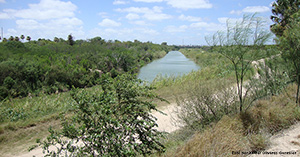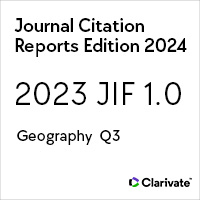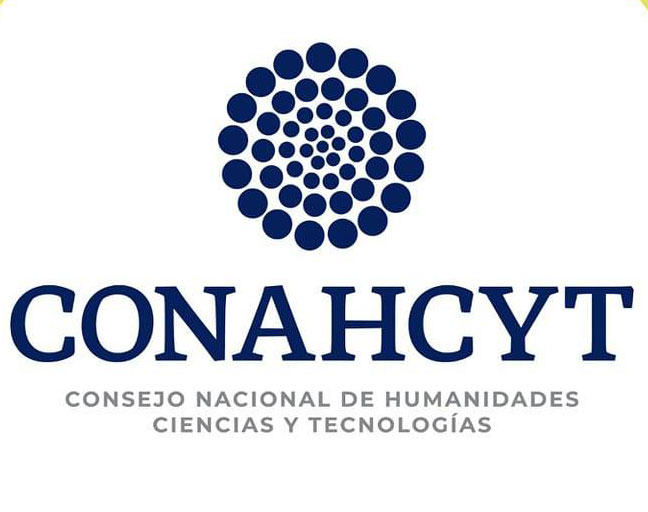The co-mingling of rebordering and debordering in territorial configurations. A field theory approach
La combinación de la refronterización y la desfronterización en la configuración territorial. Un acercamiento desde la teoría de campos
https://doi.org/10.21670/ref.2406142
Keywords:
rebordering, debordering, fields, binational park, Mexico.US borderAbstract
The article aims to explain the mingling of two opposing processes, debordering and rebordering, and their territorial implications. Field theory, specifically external relations between fields (intersection and interaction), is used to explain this. In order to test it, a qualitative methodology is applied to the analysis of a case related to the configuration of the US-Mexico border perimeter: the planning of a binational park in the twin cities of Nuevo Laredo and Laredo (2021-2022). As it is shown, the park is both a space that is jointly managed by and for both cities and a space for border surveillance. It is concluded that mingling is the result of the intersection of three fields (the environmental movement, the twin cities, and border security) on the basis of several elements common to all three (a geographical location, a plant species, and a narrative).Resumen
El objetivo del artículo es explicar la combinación de la desfronterización y la refronterización, dos procesos opuestos, y sus efectos en la configuración territorial. Para explicarlo se recurre a la teoría de campos, en particular en cuanto a las relaciones externas entre campos (la intersección e interacción). Para probarlo, se emplea una metodología cualitativa para analizar un caso referido a la configuración del perímetro fronterizo de México y Estados Unidos: la planeación de un parque binacional en las ciudades gemelas de Nuevo Laredo y Laredo (2021-2022). Como se muestra, el parque constituye a la vez un espacio gestionado conjuntamente por y para ambas ciudades y un espacio de vigilancia fronteriza. Se concluye que esta combinación es resultado de la intersección de tres campos (el movimiento ambientalista, las ciudades gemelas y la seguridad fronteriza) a partir de varios elementos compartidos por los tres (una localización geográfica, una especie vegetal y una narrativa).References
Adams, J. A. (2008). Conflict and commerce on the Rio Grande. Laredo, 1755-1955. Texas A&M University Press.
Aizeki, M., Boyce, G., Miller, T., Nevins, J. & Ticktin, M. (2021, octubre). Smart borders or a humane world? The Immigrant Defense Project’s Surveillance, Tech & Immigration Policing Project/Transnational Institute. https://www.tni.org/files/publication-downloads/smart_borders_humane_world_2021.pdf
Albert, M. & Brock, L. (1996). Debordering the world of states: new spaces in international relations. New Political Science, 18(1), 69-106. https://doi.org/10.1080/07393149608429765 DOI: https://doi.org/10.1080/07393149608429765
Alfie C., M. & Méndez B., L. H. (2000). Deterioro ambiental y movimientos sociales en Ciudad Juárez y Matamoros. Similitudes y diferencias. El Cotidiano, 16(101), 40-54.
Alfie Cohen, M. & Méndez B., L. H. (2000). Maquila y movimientos ambientalistas: examen de un riesgo compartido. Universidad Autónoma Metropolitana-Azcapotzalco. http://ilitia.cua.uam.mx:8080/jspui/handle/123456789/131
Alvarez, C. J. (2019). Border land, border water. A history of construction on the US-Mexico divide. University of Texas Press.
American Rivers. (2018, 10 de abril). Lower Rio Grande named one of America’s most endangered rivers® of 2018. https://www.americanrivers.org/media-item/lower-rio-grande-named-one-of-americas-most-endangered-rivers-of-2018/
Andreas, P. & Biersteker, T. J. (Eds.). (2003). The rebordering of North America. Integration and exclusion in a new security context. Routledge.
Benedetti, A. (2014). Espacios fronterizos del sur sudamericano. Propuesta de un modelo conceptual para su estudio. Estudios Fronterizos, 15(29), 11-47. https://doi.org/10.21670/ref.2014.29.a01 DOI: https://doi.org/10.21670/ref.2014.29.a01
Bourdieu, P. (1996). The State nobility: elite schools in the field of power. Stanford University Press. DOI: https://doi.org/10.1515/9781503615427
Bourdieu, P. & Wacquant, L. (2005). Una invitación a la sociología reflexiva. Siglo XXI.
Briggs, M. K., Poulos, H. M., Renfrow, J., Ochoa-Espinoza, J., Larson, D., Manning, P., Sirotnak, J. & Crawford, K. (2021). Choked out: battling invasive giant cane along the Rio Grande/Bravo borderlands. River Research & Applications, 37(10), 1471-1479. https://doi.org/10.1002/rra.3858 DOI: https://doi.org/10.1002/rra.3858
Chihu Amparán, A. (1998). La teoría de los campos en Pierre Bourdieu. Polis, (98), 179-198. https://polismexico.izt.uam.mx/index.php/rp/article/view/345
Coleman, M. (2005, febrero). U.S. statecraft and the U.S.-Mexico border as security/economy nexus. Political Geography, 24(2), 185-209. https://doi.org/10.1016/j.polgeo.2004.09.016 DOI: https://doi.org/10.1016/j.polgeo.2004.09.016
Colin, S. (2013). Swinging borders: the Sino-Korean border during the Sunshine Policy. En V. Gelézeau, K. de Ceuster & A. Delissen (Eds.), De-bordering Korea. Tangible and intangible legacies of the Sunshine Policy (pp. 68-84). Routledge.
Correa, J. G. & Thomas, J. M. (2023). “It’s my home, not a war zone”: Mobilizing a multitude to demilitarize the Texas Rio Grande Valley. Sociology Compass, 18(1), Artículo e13093. https://doi.org/10.1111/soc4.13093 DOI: https://doi.org/10.1111/soc4.13093
De Genova, N. (Ed.). (2017). The borders of “Europe”: Autonomy of migration, tactics of bordering. Duke University Press. DOI: https://doi.org/10.2307/j.ctv11smr05
De la Sotilla, J. (2023, 12 de julio). Texas instala un “muro flotante” con boyas en el Río Bravo para frenar la entrada de migrantes a EEUU. elDiario.es. https://www.eldiario.es/desalambre/texas-instala-muro-flotante-boyas-rio-bravo-frenar-entrada-migrantes-eeuu_1_10369138.html
Decoville, A., Durand, F. & Sohn, C. (2022). Cross-border spatial planning in border cities. Unpacking the symbolic role of borders. En E. Medeiros (Ed.), Border cities and territorial development (pp. 39-56). Routledge. https://doi.org/10.4324/9781003164753 DOI: https://doi.org/10.4324/9781003164753-5
DiMaggio, P. J. & Powell, W. W. (1983, abril). The iron cage revisited: institutional isomorpohism and collective rationality in organizational fields. American Sociological Review, 48(2), 147-160. https://doi.org/10.2307/2095101 DOI: https://doi.org/10.2307/2095101
Dunn, T. J. (1996). The militarization of the U.S.-Mexico border, 1978-1992. University of Texas Press.
Fernández, L. & Carson, R. T. (Eds.). (2003). Both sides of the border. Transboundary environmental management issues facing Mexico and the United States. Kluwer Academic Publishers.
Ferrer-Gallardo, X. (2008, marzo). The Spanish-Moroccan border complex: processes of geopolitical, functional and symbolic rebordering. Political Geography, 27(3), 301-321. https://doi.org/10.1016/j.polgeo.2007.12.004 DOI: https://doi.org/10.1016/j.polgeo.2007.12.004
Findell, E. (2023, 7 de enero). Border wall made of shipping containers comes down in Arizona, rises in Texas. The Wall Street Journal. https://www.wsj.com/articles/border-wall-made-of-shipping-containers-comes-down-in-arizona-rises-in-texas-11673061807
Fligstein, N. & McAdam, D. (2011). Toward a general theory of strategic action fields. Sociological Theory, 29(1), 1-26. https://doi.org/10.1111/j.1467-9558.2010.01385.x DOI: https://doi.org/10.1111/j.1467-9558.2010.01385.x
Fligstein, N. & McAdam, D. (2012). A theory of fields. Oxford University Press. DOI: https://doi.org/10.1093/acprof:oso/9780199859948.001.0001
Herrera, O. (2017). Nuevo Laredo. Historia de una ciudad fronteriza mexicana. Origen, traslado, transformación y modernidad. Gobierno de Nuevo Laredo/Quintanilla Ediciones.
Herzog, L. A. (2000). Shared space. Rethinking the U.S.-Mexico border environment. University of California.
Herzog, L. A. & Sohn, C. (2019). The co-mingling of bordering dynamics in the San Diego-Tijuana cross-border metropolis. Territory, Politics, Governance, 7(2), 177-199. https://doi.org/10.1080/21622671.2017.1323003 DOI: https://doi.org/10.1080/21622671.2017.1323003
Jasso-López, L. C. & Galeana-Cruz, S. (2021). Configuraciones urbanas y arquitectónicas ante la violencia y la inseguridad en Iztapalapa, Ciudad de México. Quivera Revista de Estudios Territoriales, 23(2), 111-129. https://doi.org/10.36677/qret.v23i2.15196 DOI: https://doi.org/10.36677/qret.v23i2.15196
Kolossov, V. & Scott, J. (2013). Selected conceptual issues in border studies. Belgeo. Reveu Belge de Géographie, (1). https://journals.openedition.org/belgeo/10532 DOI: https://doi.org/10.4000/belgeo.10532
Leandro, F. J. (2019, septiembre). The mesmerizing journey from Gyeongju to Lisbon: The BRI as a mechanism of de-bordering, re-bordering, and co-bordering. TalTech Journal of European Studies, 9(2), 123-152. https://doi.org/10.1515/bjes-2019-0017 DOI: https://doi.org/10.1515/bjes-2019-0017
Longo, M. (2017). The politics of borders. Sovereignty, security, and the citizen after 9/11. Cambridge University Press. https://doi.org/10.1017/9781316761663 DOI: https://doi.org/10.1017/9781316761663
Maril, R. L. (2011). The fence. National security, public safety, and illegal immigration along the U.S.-Mexico Border. Texas Tech University Press.
Martin, J. L. (2003). What is Field Theory? American Journal of Sociology, 109(1), 1-49. https://doi.org/10.1086/375201 DOI: https://doi.org/10.1086/375201
Martínez-Cantú, V. R., Wong-González, P. & Lara-Valencia, F. (2022, julio-diciembre). ¿Cuándo abren la frontera? El proceso de la fronterización durante la pandemia del Covid-19 en la región transfronteriza Sonora-Arizona. Estudios sociales. Revista de Alimentación Contemporánea y Desarrollo Regional, 32(60), Artículo e221252. https://doi.org/10.24836/es.v32i60.1252 DOI: https://doi.org/10.24836/es.v32i60.1252
Miller, J. (2023, 17 de julio). Abbott’s billion dollar barrier. The Texas Observer, 116(3), 28-37. https://www.texasobserver.org/abbotts-billion-dollar-barrier/
Miller, R. J. (2011). American Indians, the doctrine of discovery, and manifest destiny. Wyoming Law Review, 11(2), 329-349. https://scholarship.law.uwyo.edu/cgi/viewcontent.cgi?article=1254&context=wlr DOI: https://doi.org/10.59643/1942-9916.1254
Mueller, J. E. (1975). Restless river. international law and the behavior of the Rio Grande. Texas Western Press.
Muñoz, M. I. (2018). A pedagogy of water: restorying the Rio Grande/Rio Bravo (Tesis doctoral, University of British Columbia). https://open.library.ubc.ca/soa/cIRcle/collections/ubctheses/24/items/1.0372149
Nail, T. (2019). Being and motion. Oxford University Press. DOI: https://doi.org/10.1093/oso/9780190908904.001.0001
Nevins, J. (2010). Operation gatekeeper and beyond. The war on “illegals” and the remaking of the U.S.-Mexico boundary. Routledge. DOI: https://doi.org/10.4324/9780203857731
Ohmae, K. (1990). The borderless world. Power and strategy in the global marketplace. Harper Collins.
Oliveras González, X. (2019). La resistencia al muro de Estados Unidos: comparación de las espacialidades de ambos lados de la frontera. Ulúa. Revista de historia, sociedad y cultura, 17(34), 87-117. https://doi.org/10.25009/urhsc.v0i34.2662 DOI: https://doi.org/10.25009/urhsc.v0i34.2662
Oliveras González, X. (2020). La fronterización y desfronterización del río Bravo/Grande en y con los puentes internacionales. En A. Hernández Hernández (Coord.), Puentes que unen y muros que separan. Fronterización, securitización y procesos de cambio en las fronteras de México y Brasil (pp. 123-151). El Colegio de la Frontera Norte.
Overland Partners & Able City. (2021). A bi-national park-Los Dos Laredos. City of Laredo.
Paasi, A. (2022). Examining the persistence of bounded spaces: remarks on regions, territories, and the practices of bordering. Geografiska Annaler: Series B, Human Geography, 104(1), 9-26. http://dx.doi.org/10.1080/04353684.2021.2023320 DOI: https://doi.org/10.1080/04353684.2021.2023320
Peña, E. A. (2020). ¡Viva George! Celebrating Washington’s birthday at the US-Mexico Border. University of Texas Press.
Popescu, G. (2011). Bordering and Ordering the Twenty-first Century: Understanding Borders. Rowman & Littlefield.
Prieto González, J. M. (2011, enero-junio). La consolidación del Monterrey “imaginario” en el contexto de la globalización: “Macroproyectos” urbanos. Frontera Norte, 23(45), 163-191. https://doi.org/10.17428/rfn.v23i45.841
Rosière, S. & Jones, R. (2012). Teichopolitics: re-considering globalization through the role of walls and fences. Geopolitics, 17(1), 217-234. https://doi.org/10.1080/14650045.2011.574653 DOI: https://doi.org/10.1080/14650045.2011.574653
Sabet, D. M. (2008). Nonprofits and their networks. Cleaning the waters along Mexico’s Northern Border. The University of Arizona Press.
Sayer, A. (2010). Method in social science. A realist approach (2a ed. revisada). Routledge. DOI: https://doi.org/10.4324/9780203850374
Sparke, M. B. (2006, febrero). A neoliberal nexus: economy, security and the biopolitics of citizenship on the border. Political Geography, 25(2), 151-180. https://doi.org/10.1016/j.polgeo.2005.10.002 DOI: https://doi.org/10.1016/j.polgeo.2005.10.002
Swartz, D. (1997). Culture and power. The Sociology of Pierre Bourdieu. University of Chicago Press. DOI: https://doi.org/10.7208/chicago/9780226161655.001.0001
Texas State Soil and Water Conservation Board. (2015). Rio Grande carrizo cane eradication program. https://www.tsswcb.texas.gov/programs/rio-grande-carrizo-cane-eradication-program
The White House. (2023, 9 de marzo). Fact sheet: President Biden’s budget strengthens border security, enhances legal pathways, and provides resources to enforce our immigration laws. https://www.whitehouse.gov/omb/briefing-room/2023/03/09/fact-sheet-president-bidens-budget-strengthens-border-security-enhances-legal-pathways-and-provides-resources-to-enforce-our-immigration-laws/
Thomson, P. (2008). Field. En M. Grenfell (Ed.), Pierre Bourdieu. Key Concepts (pp. 67-81). Acumen. DOI: https://doi.org/10.1017/UPO9781844654031.007
US Customs and Border Protection (CBP). (2022, 19 de mayo). Border Barrier Environmental Planning-Webb County and Zapata County-April 2022. US Customs and Border Protection. https://www.cbp.gov/document/environmental-assessments/border-barrier-environmental-planning-webb-county-and-zapata
US Department of Homeland Security. (2016). Final environmental assessment. Supporting the mechanical control of carrizo cane in the Rio Grande Basin in Texas. https://www.cbp.gov/sites/default/files/assets/documents/2016-Dec/Cane%20Control_Final%20EA_120516.pdf
Van Houtum, H. & Van Naerssen, T. (2002). Bordering, ordering and othering. Tijdschrift Voor Economische en Sociale Geografie, 93(2), 125-136. https://doi.org/10.1111/1467-9663.00189 DOI: https://doi.org/10.1111/1467-9663.00189
Vega, I. I. (2018). Empathy, morality, and criminality: the legitimation narratives of U.S. Border Patrol agents. Journal of Ethnic and Migration Studies, 44(15), 2544-2561. https://doi.org/10.1080/1369183X.2017.1396888 DOI: https://doi.org/10.1080/1369183X.2017.1396888
Verea, M. (2022). La política migratoria de Biden a un año de su administración. Norteamérica, Revista Académica del CISAN-UNAM, 17(1), 265-291. https://doi.org/10.22201/cisan.24487228e.2022.1.562 DOI: https://doi.org/10.22201/cisan.24487228e.2022.1.562
Villa Sánchez, S. (2022). El wicked problem de la migración: narrativas y diseños de la política migratoria en Estados Unidos, 1990-2020. Iuris Tantum, 36(36), 144-172. https://doi.org/10.36105/iut.2022n36.06 DOI: https://doi.org/10.36105/iut.2022n36.06
Warren, R. L. (1967). The interorganizational field as a focus of investigation. Administrative Science Quarterly, 12(3), 396-419. https://doi.org/10.2307/2391312 DOI: https://doi.org/10.2307/2391312
We Build The Wall (WBTW). (2020, 17 de febrero). It’s finished: important update about where we go from here. War Room: The Wall.
Yeung, H. (2024). Theory and explanation in Geography. Wiley. DOI: https://doi.org/10.1002/9781119845515
Yuval-Davis, N., Wemyss, G. & Cassidy, K. (2019). Bordering. Polity Press.
































